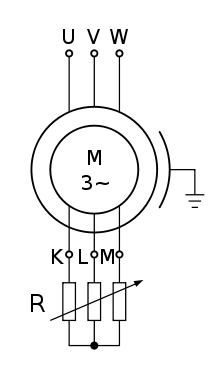Wound rotor motor
A wound-rotor motor, also known as slip ring-rotor motor, is a type of induction motor where the rotor windings are connected through slip rings to external resistance. Adjusting the resistance allows control of the speed/torque characteristic of the motor. Wound-rotor motors can be started with low inrush current, by inserting high resistance into the rotor circuit; as the motor accelerates, the resistance can be decreased.[1]

Compared to a squirrel-cage rotor, the rotor of the slip ring motor has more winding turns; the induced voltage is then higher, and the current lower, than for a squirrel-cage rotor. During the start-up a typical rotor has 3 poles connected to the slip ring. Each pole is wired in series with a variable power resistor. When the motor reaches full speed the rotor poles are switched to short circuit. During start-up the resistors reduce the field strength at the stator. As a result the inrush current is reduced. Another important advantage over squirrel-cage motors is higher starting torque.
The construction of slip ring induction motor is quite different compared to other induction motor. Slip rings Induction motor provides some advantages like provides high starting torque, low starting current and it improves the power factor. We can add external variable resistance to the rotor of this type of motor. So, we are able to control the speed of this type of motor easily[2].
A wound-rotor motor can be used in several forms of adjustable-speed drive. Certain types of variable-speed drives recover slip-frequency power from the rotor circuit and feed it back to the supply, allowing wide speed range with high energy efficiency. Doubly-fed electric machines use the slip rings to supply external power to the rotor circuit, allowing wide-range speed control. Today speed control by use of slip ring motor is mostly superseded by induction motors with variable-frequency drives.
References
- Harold J. Herbein Rotating Machinery, Rinehart Press, 1971, SBN 03-084675-7, pages 215-218
- "Slip ring Induction Motor Fundamentals - pnpntransistor". pnpntransistor. 2018-10-10. Retrieved 2018-11-23.